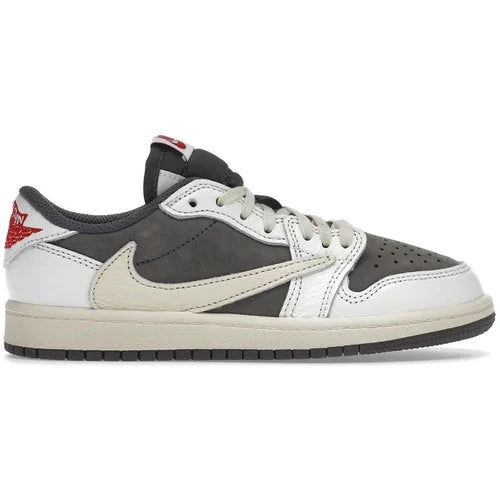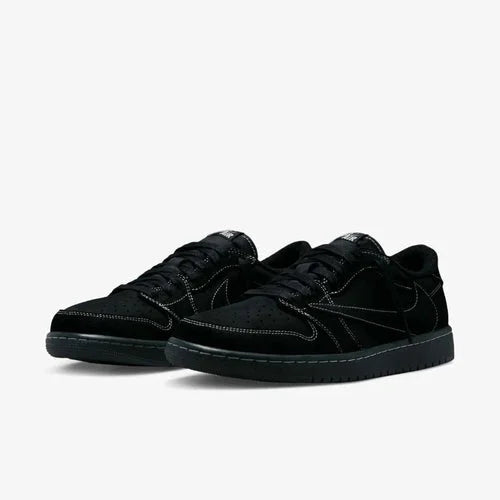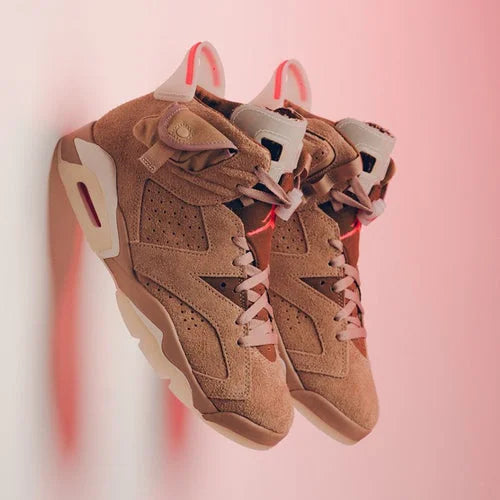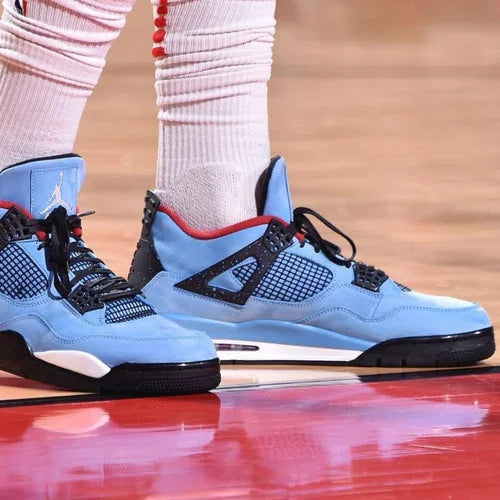How To Spot Fake Cactus Jack Dunks

A pair of fake Cactus Jack Dunks will ruin your reputation as a baller. You cannot let that happen, so it would be wise to read the next ten methods of spotting a fake pair of Cactus Jack Dunks!
However, if you still have doubts even after reading through our guide and checking every box, you can always contact our team to have your new pair of Cactus Jack Dunks checked!
Table of Contents
[ open ]Identifying the Outer Swoosh: Placement and Pattern
Let's begin with the most distinctive feature of every Nike Dunk pair - the Swoosh. Specifically, the outer Swoosh.
The correct placement of the Swoosh is in the middle of the shoe, neither too high nor too low. Take a look at the collage below for a clearer comparison. In the case of the replica TS Dunk, you'll notice that its Swoosh is positioned much lower than it should be.
Moving on, pay attention to the texture of the velvet overlays and look for any irregularities in the plaid pattern. One common characteristic of fakes is having more brown lines/squares and fewer white squares.

Spotting Issues with the Inner Swoosh: Shape, Eyelets, and Print Quality
Let's move on to the next crucial detail - the inner Swoosh! While it may not differ significantly, you can employ the same authentication methods we used for the outer Swoosh, focusing on the shape and placement. However, there are a couple more aspects worth considering here.
It's quite evident that the eyelets on the replica look untidy, with peculiar white borders and protruding threads. In contrast, the eyelets should appear neater and slightly smaller on the authentic Dunks.
Next, observe the Swoosh itself. Notice how the counterfeit version lacks that smooth curve and features a sharp, pointy tip. Additionally, the fake Swoosh is thicker than the original, and even though the difference might be subtle, it's noticeable upon careful inspection.
Lastly, pay close attention to the print of the black overlay. The authentic one exhibits thinner lines and a more hand-drawn, messy appearance. Conversely, the counterfeit version has thicker lines and appears printed.

Verifying the Cactus Jack Tag: Dimensions, Texture, and Stitching
Let's focus on the essential elements to verify here: the tongue label's dimensions and the suede's texture.
Regarding the dimensions, pay attention to the thickness of the original tag, which should be slightly thicker, but approximately the same length as the fake one. The font of the Cactus Jack logo is generally similar between the two, so we can move on to inspecting the textures and stitching.
When it comes to stitching, both the original and fake shoes tend to have very small and evenly sized stitches, making it harder to distinguish them in this aspect.
However, the real difference lies in the texture of the fabric. The genuine tongue label should feel smoother, while the fake counterpart will have a more grainy texture.

Inspecting the “Made in Vietnam” Tag: Stitching and Text Alignment
Another valuable tip for authenticating this model is examining the Made in Vietnam tag. We’ll follow the same approach as previously.
An interesting detail is the stitching pattern on the lower half of the tag. Specifically, there should be two stitched lines with some distance between them, and they should not touch the lines of text.
However, these lines are placed much lower on the replica than they should be, intersecting with the text lines. Not only that but the two bottom lines of text are also positioned way too low on the tag on the fake version, making it easy to authenticate the fake sneakers.

Checking the Toebox: Fit, Perforations, and Laces
Now, let's move on to the next method, which involves examining the toe box. One of the significant differences to look out for is the width.
SB Dunks typically have a more narrow fit, especially around the toe box. However, replicating this narrow fit can be challenging so the fake Dunk Travis Scott may have a wider toe box in comparison.
Next, pay attention to the shoelaces. The authentic laces are not only wider but also flat in shape. Conversely, inauthentic ones are more round and thin, deviating from the original design.
Lastly, focus on verifying the size and spacing of the perforations on the toe box.
In the replica case, the perforations may be placed much further away from each other than they should be according to the authentic design.

Analyzing the Heel Tab: Logo, Stitching, and Placement
Take note of the shape and placement of the heel tab and the logo. The authentic heel tab should be slightly taller and wider than the fake one. Additionally, the Nike logo on the genuine pair should be positioned lower than on the counterfeit item.
The most notable difference is the size, which is larger than the original. Pay attention to the embroidery pattern, which should be done in a very recognizable manner. Ensure that the threading is dense enough, with no threads sticking out or disrupting the pattern in any way. Utilizing a fake VS real Travis Scott SB Dunks comparison can be helpful in this regard.
Also, pay attention to the stitching around the heel tab. On the authentic pair, the stitches should be small and delicate, certainly smaller than what you'll find on the counterfeit.

Hopefully, this guide has been helpful for you so far. For all lovers of Travis Scott / Cactus Jack sneakers, we want to suggest reading our guides on other TS models: Travis Scott Jordan 1 High , Cactus Jack Jordan 4 , Travis Scott Jordan 1 Low.
Evaluating the Outsole Logo: Texture, Color, and Trademark Marks
You may notice color differences on the outsole when comparing the real vs. fake Travis Scott Dunks. However, it's a complicated aspect to judge, as it can be a flaw in replicas, but it may also vary depending on the lighting.
But don't worry. We have a couple more tips to assist in TS Dunk authentication! In one of the mini pictures, you can observe the difference in the textures of the rubber outsole. Both pairs exhibit a "grainy" texture, but the grains are more prominent and larger on the genuine shoe than on the fake.
One of the most noticeable things that could be improved is the size of the logo, which is smaller on the replica. The authentic logo should have two ® trademark signs, one above the Swoosh and another above the Nike text. The ® signs should also be slightly tilted sidewards, similar to the Nike logo. The genuine ® signs are also a bit bigger.
Lastly, observe the positioning of the Swoosh about the text. On the fake, the two elements almost touch each other, whereas, on the authentic pair, the Swoosh should be located further away from the text.

Authenticating the Shoelaces: Texture, Quality, and Packaging
When examining the shoelaces, some noticeable differences can help with authentication.
Firstly, the fake laces are smaller and thinner than the authentic ones. While this may not reflect the quality, it could be a manufacturing error in choosing the wrong size for the laces.
However, the more crucial aspect to focus on is the texture of the shoelace. Genuine ones are highly stretchable yet very dense and durable, making them less susceptible to tearing or breaking.
On the other hand, the fake laces are thinner and of cheaper quality, making them more vulnerable to damage when worn.
An additional noteworthy detail is that the shoelaces of this model are often provided separately in a ziplock bag with a Nike logo printed on it. Ensure this bag is included with your pair, as it's a typical packaging characteristic.
Lastly, let's examine the logo on the laces. The comparison shows that the fake logo has a completely different font, featuring larger and thicker letters. Moreover, they are less tilted sideways when compared to the authentic ones.

Reviewing the Shoebox Label: Fonts, Spacing, and Logo Differences
Let's focus on the shoe box, an essential authentication aspect. The TS Dunks come in a stylish box with a plaid pattern, but we're particularly interested in the size label and its fonts and spacings.
Starting with the Nike SB logo, you'll notice significant differences between the real and fake versions—the genuine logo features thinner letters, larger spacings, and a more tilted font than the counterfeit. Additionally, note that the replica lacks the "suggested retail" bar on the side, which is on the authentic box.
Next, pay attention to the first row from the top, which states the model's name. It should be written in regular font, not in bold. The same mistake can be observed in the 2nd and 3rd top rows, the sizes, and the product code.

Do Nike SB Dunks Fit True to Size?
The Nike SB dunk fit is pretty true to size. For some people, however, they fit too tightly, so you should go half a size up if you have wide feet.
Styling Ideas: What to Wear with Travis Scott Dunks
These sneakers are extremely versatile and offer tons of styling opportunities. However, they look best with loose trousers and brown/earth tones. You can always go right with keeping it simple and casual!
Where Can I Get My Travis Scott Dunks Authenticated?
We offer our excellent authentication service if you want to be 100% sure your dunks are real. Text us using our live chat option, and our helpful professionals will quickly provide a detailed response.
See it here: Cactus Jack legit check .
Conclusion: Spot the Fakes with Confidence
It’s important to take your time, compare with trusted references, and if in doubt, rely on professional authentication services.
Nike SB Dunk Low Travis Scott fake vs real - key red flags to avoid:
- Sloppy stitching: Uneven or loose threads around the swoosh, heel tab, or toebox.
- Incorrect swoosh shape: The outer or inner swoosh might be too thick, short, or poorly placed.
- Low-quality tags: Faded text, wrong alignment, or poor stitching on the "Cactus Jack" or "Made in Vietnam" tags.
- Cheap materials: Stiff or synthetic leather and overly shiny surfaces.
- Toebox deformities: An unnatural shape or poorly spaced perforations.
- Mismatched shoelaces or colors: Laces that feel thin, frayed, or incorrectly colored.
- Inaccurate box label: Misspelled words, incorrect fonts, or improper spacing on the shoebox label.
- Flawed outsole logos: Blurry trademarks or inconsistent patterns on the outsole.
When in doubt, use a trusted authentication service to verify your pair before making a commitment.















